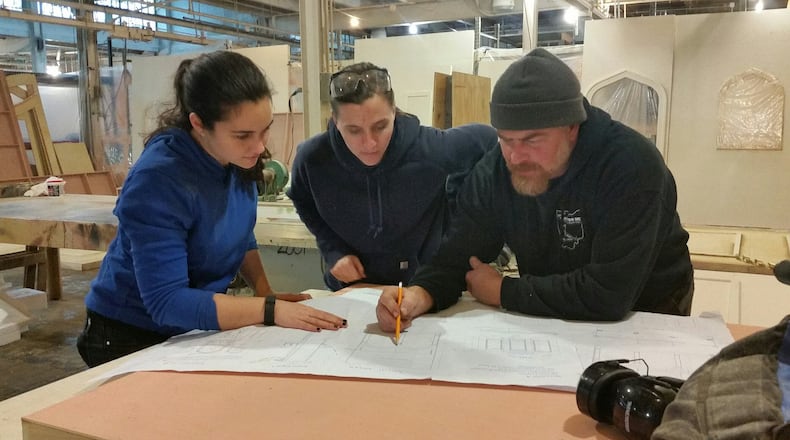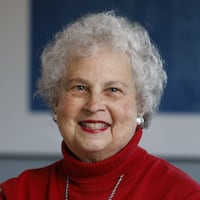“It’s an opera that’s just not done as much but I wanted to do the piece because it’s a great singers’ opera with a lot of virtuosic pieces,” Bankston says. “We typically go out into the market and find a production that fits on our stage that’s within our budget and rent it,” explains Bankston, who is now in his 21st year with Dayton Opera. “There’s a database of information through our trade organization, Opera America.”
He says it’s an easy search when it comes to the famous and most-produced operas such as “Aida,” “La Boheme” or “Madama Butterfly.” Over the course of the Dayton Opera’s 56-year history, there’s always been an appropriate set available. In the years that Dayton shared productions with the Michigan Opera Theatre in Detroit, the companies commissioned sets to be built, but they were not done locally.
That’s all about to change with the upcoming production slated for Friday, Feb. 17 and Sunday, Feb. 19 at the Schuster Center. Not only will “The Abduction from the Seraglio” be produced for the first time, but it’s the first time in the history of Dayton Opera that a set is being designed and built locally.
Wright State scenic designer supervises
Pam Knauert Lavarnway, best known for her theater sets at Wright State University, was selected to come up with designs that would complement the comic tale of two women purchased from pirates by a Pasha and their eventual rescue by their lovers.
“How often do you get to design something that takes place in a Turkish harem?” asks Lavarnway, who says she loves Mozart and was really excited to get the call. As professor of theatre and coordinator of the Theatre Design and Technology program at Wright State, she’s designed more than 50 shows at the school over the past 26 years. She’s also designed sets for the Victoria Theatre, the Human Race Theatre Company and Bernstein’s Mass with the Dayton Philharmonic.
“Set design is pretty demanding and requires a complex set of skills,” Lavarnway explains. “You have to know theater history, art history, architecture, how things are built. You have to be able to draft everything to the exact specifications because you’re going to give your drawings to a shop and that’s what they’ll use to build the sets.”
Discovering a passion
In Lavarnway’s case, the passion for scenic design began with a childhood love of art. She grew up in upstate New York with a mother who was a fashion illustrator. “I grew up drawing fashions a lot with my mother, which later translated into costume design.”
She assumed she would also become an illustrator but changed her mind in high school, inspired by an art teacher who was very involved with theater. “So I started working on sets and what I loved was that I could combine my love for drawing and painting with my love for literature. The idea to me of illustrating stories and narratives pieces in three dimensions was really exciting to me. I fell in love with that.”
After studying set design at college and graduate school, Lavarnway worked as a scenic charge artist in regional theaters throughout the country including Berkeley Repertory Theatre, Studio Arena in Buffalo and Huntington Theatre Company in Boston. A charge artist, she explains, leads and oversees the painting of scenery. “I got to work with great designers, some of the best,” she says.
When she decided she might enjoy teaching, she ended up at Binghamton University in New York, but after a few years decided she wanted a school that offered a Bachelor of Fine Arts in theater design and technology. When she saw an ad for a position at Wright State that seemed like a perfect match, she decided to apply.
“I love the students and being part of their training,” she says. “And I love my colleagues. When you’re in a place for a long time you establish wonderful collaborative relationships and that’s especially true with the directors I work with here.”
Designing an opera set
“The Abduction from the Seraglio” will be Lavarnway’s second opera commission. “The same year I came to Wright State, a British director recommended me for a design job at the Skylight Opera Theatre in Milwaukee,” she says, adding that designing an opera set is very similar to designing the set for a musical. “They are both driven a lot by the music and the character of the music,” she says.
The set that will fill the Mead Theatre stage at the Schuster Center has been a year in the making. Lavarnway says the first thing she did was to listen to the music and obtain a libretto, the opera text. She began meeting with Bankston and stage director Kathleen Clawson, who is returning to Dayton for the 10th time to direct the production.
The opera’s first act takes place outside the palace walls, the second act inside the walls in a courtyard and the third, outside the bedroom walls. A platform for the chorus was also required.
“Originally we talked about trying to use projections as much as possible,” Lavernway says. “But in the third act we needed two second-story balconies that the characters could climb to on ladders and we realized we needed substantial scenery to do that. So our ideas evolved, and we decided to create two double-sided large wagons, each one a big part of the palace.” A wagon, she explains, is a unit of scenery on wheels.
Lavernway says one of her favorite parts of the job is the research. “It’s learning about something new every time,” she says. “In this case I looked everywhere to find out what these things would look like. I went to the library, went online for image searches to read about Turkish architecture. “
It was a lot of fun, she says, because it was a style that wasn’t familiar to her. Specific problems had to be solved.
“The first act calls for a character to prune a fig tree and you could do that in different ways,” Lavernway says. “You might put a mini-tree in a pot, for example.”
But Clawson had something else in mind: a large overhanging branch that hung over the big palace wall. “So instead of a miniature three-dimensional tree, we have a cut-out flat piece that flies in with stylized fig branch painted on it,” says Lavernway. “It will have little three dimensional figs that velcro to it that he can pick the figs off from the ladder.”
Completing the plans
After coming up with some rough sketches and meeting with Clawson and Bankston, Lavernway produced a final scenic rendering. That was turned over to Tristan Cupp, artistic director for Zoot Theatre who produced some scenic elements for the Dayton Opera’s “The Book Collector.” Cupp was asked to oversee the constuction, working with a staff of carpenters and Lavernway’s assistant, Ryan Sess.
After regularly checking in at the warehouse and helping with the painting, Lavernway says she’ll attend the technical and dress rehearsals to make sure that everything is running smoothly and any last-minute problems are solved. Her job officially ends on opening night.
About the cast
The opera will be sung in German with English surtitles. Making her Dayton Opera debut as lead soprano Constanze is Amanda Woodbury who comes to Dayton from a recent run as Juliette in the new production of “Roméo et Juliette” with the Metropolitan Opera. She is a recent second-place winner of Plácido Domingo’s prestigious Operalia competition and recipient of a Career Grant from the Richard Tucker Foundation.
The role of Belmonte is being played by tenor Tyler Nelson. Tenor Robert Norman returns to Dayton as Pedrillo and artist-in-residence soprano Chelsea Friedlander will portray Blonde. Bass-baritone Jeremy Galyon will play Osmin.
Rounding out the colorful cast of characters is Jamie Cordes, actor and singer with The Human Race Theatre Company. Cordes will perform the speaking role of the Pasha Selim, ruler of the exotic Turkish harem.
Glenn Lewis, on staff at the Sante Fe Opera, will conduct and the Dayton Opera Chorus will add to the fun.
Bankston is excited about his upcoming production and about the “firsts” it will mean for Dayton Opera. He’s hoping the finished set might be rented out to other companies around the country.
“It’s greatly energizing to do your own thing,” he concludes. “You can fashion it the way you really want it done. It’s like building your own house which can be a blessing or a curse. So far, we haven’t found the curse!”
WANT TO GO?
What: The Dayton Opera premiere production of Mozart's "The Abduction from the Seraglio"
When: 8 p.m. Friday, Feb. 17 at 8 p.m. and 3 p.m. Sunday, Feb. 19
Where: Schuster Center, 1 W. Second St., Dayton
Tickets: $28 to $94 available at www.daytonperformingarts.org or by calling Ticket Center Stage at (937) 228-3630. Senior, student, and military discounts are available.
RELATED PROGRAMMING:
A free pre-performance talk by University of Dayton music professor Sam Dorf is held one hour before each show. “Opera bites” are also available in the Wintergarden at the first intermission.
About the Author


